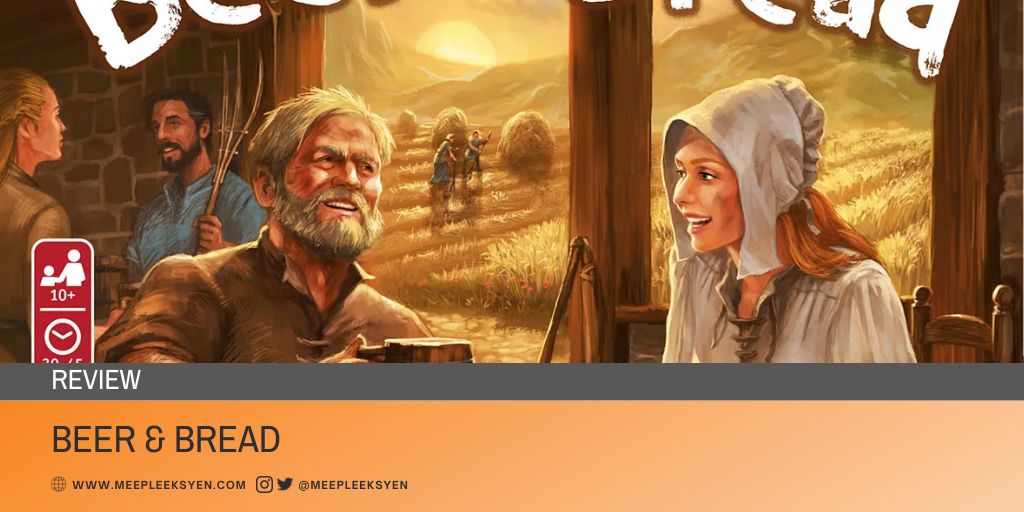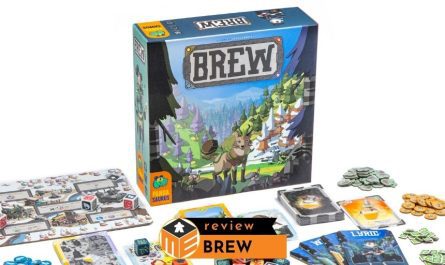In the quaint countryside, two cosy hamlets steeped in their rich heritage of brewing and the proud traditions in baking. Both live and collaborate, breaking breads among them while enjoying a pint of beer. Despite this docile and cordial manners, they are engaged in a delightful and friendly yet fierce village rivalry. With their commodities standing as pillars of the age-old culinary treasures, it’s a given that their annual contest extends more than just a casual fair. This is the backbone of Beer and Bread, another game crafted by the ingenious Scott Almes. It surely ticks the ‘tiny’ on the list, but will it be ‘epic’?
A short disclaimer before you read my board game analysis
As an avid euro gamer and hardcore Legend of the Five Rings (L5R) LCG player, my reviews may reflect a preference for these styles, and I may not cover solo games/variants extensively. Please note that my personal remarks are based on my gaming experiences, and I aim to provide honest insights within the scope of my preferences.
Beer & Bread, the card structure
Beer & Bread steps in as another attempt to deliver a euro-game experience tailored specifically for two players. Packed within are a touch of complexity and a clever hand management element. It’s something we rarely found in a game in this compact format. The secret ingredients: multi-use cards. Divided into three distinct sections, these cards are versatile. It paves the way for a range of three in-game actions.
The top part allows players to harvest resources. Meanwhile, a recipe for either crafting beer and baking delectable bread are unveiled in the middle section, along with the resources required to produce them. Last, but not least, the bottom area depicts the nifty upgrades to level up your operations. All of these actions are conveyed clearly, accompanied by decent artworks.
OPINION on the gameplay
As mentioned, our designer adds layers of decision-making that provokes pondering and contemplation. The versatile multi-use cards deepens the complexity when cleverly integrated with alternating seasons. The latter one depicts the rounds played in Beer and Bread. They are characterized by abundant, fruitful seasons and the challenging spells of dry ones. Both impacts directly how players acquire their card and indirectly in terms of the utilization. This ever-shifting seasons keep us always on our toes.
During the fruitful season, resources are bountiful. Players take turns drafting and immediately playing their multi-use cards. The rest of hands will get circulated to the opponent after each turn. The chosen action dictates where we need to place the cards post-action. For instance, the cards will settle in our playing area.
And when Beer & Bread are produced and upgrades are installed, they will end up in our barn. While the fruitful season drifts and after the inevitable change elapses, the utilization of these cards in this season will be pivotal. Because…
…as soon as the dry season rolls in, the card drafting mechanic takes a backseat. Beer & Bread still has a new twist in its sleeve. The brand-new rule is imposed, where players are challenged to make the most of the cards utilized for harvesting in the preceding rounds. These are the cards we place in front of our player area. And thus, this clever implementation injects another layer of depth into Beer & Bread, demanding ongoing planning for every pair of fruitful and dry seasons.
The intricate mechanics not only elevates the game’s strategic nature. It also seamlessly blends to the narrative backdrop. In addition, the game also provides less resources during the dry season. Everything fits. The execution is a delight. Through these elements, Beer & Bread impeccably brings out the strong thematic background to the forefront.
Limitation, restriction, and efficiency.
Beer & Bread gracefully dances with its artful balance of constraints and limitations. Surprisingly, the game does not feel restrictive or punitive, even when an occasional misplay occurs. Take the resources throughout both fruitful and dry seasons, for example. Granted, the fruitful is more bountiful than the dry, yet scarcity could still persist. Hence, players must strategically harvest resource. It paves the way for more substantial production down the line.
A key point emerges here, as the game averts the potential hazard of over-harvesting. There is no advantage in excessive resource hoarding, and the limited space in your storehouse prevents this from happening. In no way, it is a good idea to do so. When it’s bursting at the seams, your surplus must be offered to the neighbour (read: your opposing player), fostering a sense of camaraderie in this friendly village rivalry. Both hamlets aim for prosperity. And wastefulness is not the name of this game.
Another noteworthy aspect is the initial production constraints. At default, players are only allowed to produce only one barrel of beer and a single loaf of bread. Until the production site is tidied up through the upgrade installations, the yield level for each commodity remains capped. Thus, playing the upgrade strategically becomes essential. I usually station this upgrade when I have both beer and bread produced, and this action facilitate the smooth transition from the production site to getting sold in a go. This is where they await their eventual point tally at the game’s conclusion. With this particular implementation, it allows players to efficiently optimize the output, and perhaps, increase the production capacity through the right upgrade.
A twist in the scoring
Now, some cunning farmers might initially believe that a straightforward path to winning the game involves focusing solely on either beer or bread. Well, once again, that’s not the name of this game. It’s Beer & Bread. It’s very fortunate, Scott Almes foresaw this possibility and has deftly woven a simple yet effective solution to close this loophole. He dictates that both villages will only score the lower tally between both commodities.
A specialization in just either beer or bread won’t cut it. We must maintain the delicate balance between these two staples. It is crucial to keep the difference between sales of these commodities in check. Otherwise, the gap is too big. And we won’t really score much. The judge presiding over this annual contest won’t turn a blind to a village starved of bread or parched and deprived of its beer.
Verdict
Scott ventures into the exciting (and pretty much underestimated) two-player terrain. I must admit that the allure of Beer and Bread lies in the thematic indulgence of the long tradition of alcohol refreshment and freshly baked bread. Yet, the perfectly tailored duel format is undeniably the ultimate catalyst that drove me to acquire this gem to my collection.
Beer & Bread encapsulates the rich thematic and narrative backdrop. This aspect is seamlessly blending with the quintessential vibe of euro game. An appeal for a player count of two. Despite using the multi-use card as its backbone, Scott Almes transcends the mundane routine of draw a card, take the printed actions, discard, and repeat. He brings out something more from this mechanic. The end product is an elevated gameplay experience, thanks to its climactic twist in scoring and a series of restrictions and limitations.
This game secures its well-deserved place as a permanent fixture on my gaming shelf. Beer & Bread has established its existence as a frequent guest at my gaming table. It’s all thanks to the accessible rules and approachable appearance. The game does not look intimidating. And not too abstract, either. Besides the ample table presence, the rulebook makes teaching the game to others a breeze. The advantage of its lower player count ensures the game sees the light of the day more often as well. No massive group necessary to initiate the fun. Scott Almes, therefore, has undoubtedly set a new benchmark for what constitutes a top-notch game for two.
I am a full-time food technologist during weekdays. However, when the calendar hits weekends, I transform into an avid board gamer. I am a hardcore Legend of the Five Rings (L5R) LCG player from Fantasy Flight Games (FFG). Current hobby: buying board games. My shelf of shame’s list is getting longer, thanks to you, Kickstarter.





